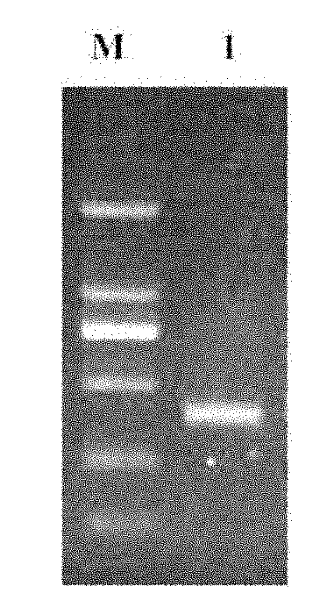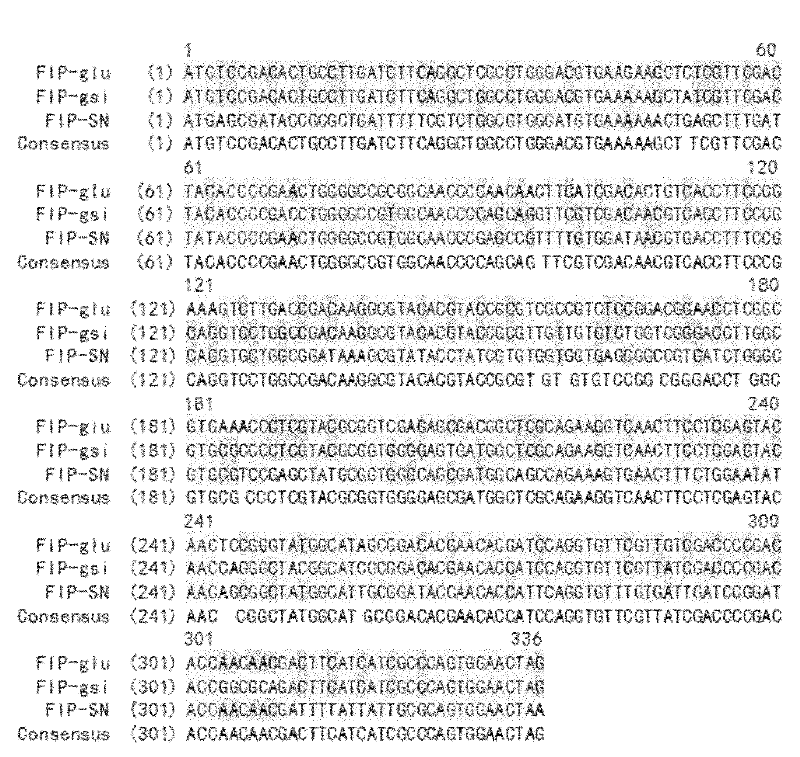Recombinant fungal immunomodulatory protein gene in Ganoderma lucidum, protein coded whereby and application thereof
A technology of immunomodulatory proteins and fungi, applied in the fields of application, genetic engineering, plant gene improvement, etc., to achieve the effects of easy construction, simple expression method, and simple separation and purification process
- Summary
- Abstract
- Description
- Claims
- Application Information
AI Technical Summary
Problems solved by technology
Method used
Image
Examples
Embodiment 1
[0024] Example 1, Gene Recombination of Fungal Immunomodulatory Proteins in Ganoderma
[0025] 1. Fragment Synthesis
[0026] According to the preferred codons of Escherichia coli, the fungal immunoregulatory protein gene (FIP-glu) and the fungal immunoregulatory protein gene (FIP-gsi) of Chizhi were recoded without changing their protein sequences. The FIP-glu and FIP-gsi genes recoded according to the E. coli preferred codons were divided into 50-60bp length fragments according to their DNA sequence, and there was about 18bp nucleotide overlap between every two adjacent fragments (SEQ ID NO.3 to SEQ ID NO.20), and these fragments were synthesized.
[0027] 2. Primer-free PCR
[0028] The oligonucleotides shown in SEQ ID NO.3 to SEQ ID NO.20 were mixed in equal amounts. The mixed gene fragments were subjected to PCR reaction using KOD plus polymerase (Toyobo, Japan). There are no primers in the reaction system. The reaction program was as follows: after pre-denaturation ...
Embodiment 2
[0039] Example 2, Construction and Screening of Recombinant Ganoderma Fungus Immunomodulatory Protein Gene Expression Vector
[0040] The product II obtained in Example 1.3 was digested overnight with restriction endonucleases BamH I and Hind III, and ligated with the expression vector pQE-30 digested with the same restriction endonucleases. The constructed expression vector was transformed into Escherichia coli M15 host cells, and transformants were screened with LB plates containing 100 mg / mL carbenicillin sodium and 50 mg / mL kanamycin. The cloning plasmid is extracted to obtain the expression vector of the recombinant ganoderma fungus immunoregulatory protein. The obtained transformant is the recombination library of the immunoregulatory protein gene of the fungus of the genus Ganoderma lucidum. Screen the transformants of the recombinant Ganoderma lucidum fungal immunoregulatory protein gene. When the transformant colony grows to a diameter of 1 mm, the colony is blotted...
Embodiment 3
[0041] Example 3. Induced Expression and Purification of Recombinant Fungal Immunomodulatory Proteins in the Genus Ganoderma
[0042] 1. Induced expression and Western blot detection of recombinant fungal immunomodulatory proteins in Ganoderma lucidum
[0043] The single clone obtained in Example 2 was inoculated into LB liquid medium containing 100 mg / mL carbenicillin sodium and 50 mg / mL kanamycin, and cultured overnight at 37° C. with shaking. The next day, inoculate a larger volume of culture medium with 2% inoculum. Continue culturing at 37°C, and when OD600 reaches 0.5-0.7, add IPTG to make the final concentration of IPTG reach 1 mM. After culturing for 6 hours, the obtained bacterial liquid samples were centrifuged at 5,000 rpm for 20 minutes to collect bacterial cells. The supernatant was removed, and the cells were washed with 100 μL 2×SDS-PAGESample buffer (100 mM pH 6.8 Tris-Cl, 4% (W / V) SDS, 0.2% (W / V) BPB, 20% (W / V) glycerine, 2 % (W / V) β-ME) was suspended and k...
PUM
 Login to View More
Login to View More Abstract
Description
Claims
Application Information
 Login to View More
Login to View More - R&D
- Intellectual Property
- Life Sciences
- Materials
- Tech Scout
- Unparalleled Data Quality
- Higher Quality Content
- 60% Fewer Hallucinations
Browse by: Latest US Patents, China's latest patents, Technical Efficacy Thesaurus, Application Domain, Technology Topic, Popular Technical Reports.
© 2025 PatSnap. All rights reserved.Legal|Privacy policy|Modern Slavery Act Transparency Statement|Sitemap|About US| Contact US: help@patsnap.com



